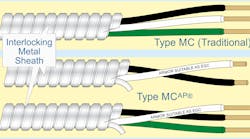The NEC Chapter Three wiring methods include various cable types, such as: 1) armored cable (Type AC) [Art. 320]; 2) metal-clad cable (Type MC) [Art. 330]; 3) nonmetallic-sheathed cable (Types NM and NMC) [Art. 334]; 4) power and control tray cable: Type TC [Art. 336]; and 5) service-entrance cable: Types SE and USE [Art. 338].
Armored cable is an assembly of insulated conductors, 14 AWG through 1 AWG, individually wrapped within waxed paper and contained within a flexible spiral, interlocked metal armor with an internal bonding strip in intimate contact with the armor for its entire length.
Metal-clad cable (Type MC) is a factory assembly of insulated circuit conductors, with or without optical fiber members, enclosed in an armor of interlocking metal tape (or metallic sheath) [Sec. 330.2]. Because the outer sheath of traditional interlocked Type MC cable isn’t listed as an equipment grounding conductor (EGC) [Sec. 250.118(10)a.], Type MC contains an EGC [Sec. 330.108]. There is a Type MC cable where the metallic sheath is combined with a bare EGC that does qualify the cable as an EGC [Sec. 250.118(10)b.] (Fig. 1).
Nonmetallic-sheathed cable (Types NM and NMC) encloses two or more insulated conductors, 14 AWG through 2 AWG, within a nonmetallic jacket [Sec. 334.2]. NM cable has insulated conductors enclosed within an overall nonmetallic jacket. The jacket of Type NMC cable is also corrosion-resistant.
Power and control tray cable (Type TC) is a factory assembly of two or more insulated conductors under a nonmetallic jacket [Sec. 336.2].
Service-entrance cable is a single or multiconductor assembly, with or without an overall covering, used primarily for services [Sec. 338.2]. Type SE and SER cables have a flame-retardant, moisture-resistant covering. SER cable has an insulated neutral (resulting in three insulated conductors) with an uninsulated EGC. SER cable is round, while 2-wire SE cable is flat. Type USE cable is for underground applications; its covering is moisture resistant, but not flame-retardant.
Uses
Type AC Cable
You can use armored cable for [Sec. 320.10]:
(1) Feeders and branch circuits in exposed or concealed installations.
(2) Cable trays.
(3) Dry locations.
(4) Embedded in plaster or brick, except in damp or wet locations.
(5) Air voids where not exposed to excessive moisture or dampness.
You can also install armored cable in a plenum space where listed for use in an air-handling space [Sec. 300.22(C)(1)] However, you can’t use it [Sec. 320.12]:
(1) Where subject to physical damage.
(2) In damp or wet locations.
(3) In air voids of masonry block or tile walls where such walls are exposed or subject to excessive moisture or dampness.
(4) Where exposed to corrosive conditions.
Type MC Cable
The general uses for metal clad cable (Type MC) include [Sec. 330.10(A)]:
(1) In branch circuits, feeders, and services.
(2) In power, lighting, control, and signal circuits.
(3) Indoors or outdoors.
(4) Exposed or concealed.
(5) Directly buried if identified for the purpose.
(6) In a cable tray.
(7) In a raceway.
(8) As aerial cable on a messenger.
(9) In hazardous locations as permitted in Secs. 501.10(B), 502.10(B), and 503.10.
(10) Embedded in plaster or brick in dry locations.
(11) In wet locations, where a corrosion-resistant jacket is provided over the metal sheath and any of the following are met:
a. The metallic covering is impervious to moisture.
b. A jacket is provided under the metal covering that’s moisture resistant.
c. The insulated conductors under the metallic covering are listed for use in wet locations.
(12) If single-conductor cables are used, all circuit conductors must be grouped together to minimize induced voltage on the sheath [Sec. 300.3(B)].
Specific uses for Type MC cable include [330.10(B)]:
(1) In a cable tray per Art. 392.
(2) Direct buried (cables must be protected per Sec. 300.50).
(3) Installed as service-entrance cable (if installed per Sec. 230.43).
(4) Installed outside of buildings; it must comply with Secs. 225.10, 396.10, and 396.12.
But you can’t use it [Sec. 330.12] where it’s:
(1) Subject to physical damage.
(2) Exposed to the destructive corrosive conditions in (a) or (b), unless the metallic sheath or armor is resistant to the conditions (or protected by material resistant to the conditions):
a. Direct burial in the earth or embedded in concrete unless identified for the application.
b. Exposed to cinder fills, strong chlorides, caustic alkalis, or vapors of chlorine or of hydrochloric acids.
Type NM and NMC Cable
You can use Type NM and Type NMC cables for [Sec. 334.10]:
(1) One- and two-family dwellings of any height, and their attached/detached garages or storage buildings.
(2) Multifamily dwellings permitted to be of Types III, IV, and V construction. See Annex E for the determination of building types [NFPA 220, Table 3-1].
(3) Other structures permitted to be of Types III, IV, and V construction. Cables must be concealed within walls, floors, or ceilings that provide a thermal barrier of material with at least a 15-min. finish rating, as identified in listings of fire-rated assemblies.
But you can’t use Types NM or NMC cables [Sec. 334.12(A)]:
(1) In any dwelling or structure not specifically permitted in Sec. 334.10(1), (2), (3), and (5).
(2) Exposed within a dropped or suspended ceiling cavity in other than one- and two-family, and multi-family dwellings.
(3) As service-entrance cable.
(4) In commercial garages having hazardous locations, as defined in Sec. 511.3.
(5) In theaters and similar locations, except where permitted in Sec. 518.4(B).
(6) In motion picture studios.
(7) In storage battery rooms.
(8) In hoistways, or on elevators or escalators.
(9) Embedded in poured cement, concrete, or aggregate.
(10) In any hazardous location, except where permitted by other sections in the Code.
And you can’t use Type NM cables:
(1) If exposed to corrosive fumes or vapors.
(2) If embedded in masonry, concrete, adobe, fill, or plaster.
(3) In a shallow chase in masonry, concrete, or adobe and covered with plaster, adobe, or similar finish.
(4) In wet or damp locations (Fig. 2). A raceway in a ground floor slab is considered a wet location [Sec. 300.5(B)].
Type TC Cable
You can use power and control tray cable (Type TC) in [Sec. 336.10]:
(1) Power, lighting, control, and signal circuits.
(2) Cable trays including those with mechanically discontinuous segments up to 1 ft.
(3) Raceways.
(4) Outdoor locations supported by a messenger wire.
(5) Class 1 circuits as permitted in Parts II and III of Art. 725.
(6) Nonpower-limited fire alarm circuits per Sec. 760.49.
(7) Between a cable tray and equipment if it complies with Sec. 336.10(7)a through f.
(8) Wet locations where the cable is resistant to moisture and corrosive agents.
(9) One- and two-family dwellings, Type TC‑ER cable is permitted per Part II of Art. 334.
(10) Direct buried where identified for direct burial.
But you can’t use Type TC cables [Sec. 336.12]:
(1) Where exposed to physical damage
(2) Outside a raceway or cable tray system, except as permitted in Secs. 336.10(4), 336.10(7), 336.10(9), and 336.10(10)
(3) Exposed to direct rays of the sun, unless identified as sunlight resistant.
Type SE and USE Cables
You can use service-entrance cable as [Sec. 338.10]:
• Service-entrance conductors, if installed per Art. 230.
• Branch circuits and feeders where the circuit conductors are insulated.
SE cable is permitted for branch circuits and feeders if the insulated conductors are used for circuit wiring, and the uninsulated conductor is used only for equipment grounding (Fig. 3).
Exception: In existing installations, uninsulated conductors may be used for the neutral conductor if the uninsulated neutral conductor of the cable originates in service equipment.
SE cable used for branch circuits or feeders must comply with Sec. 338.10(B)(4)(a) and (b).
(a) Interior installations. Install per the same requirements as Type NM Cable — Art. 334, excluding Sec. 334.80.
Where installed in thermal insulation, the ampacity of conductors 10 AWG and smaller, must be sized with the 60°C (140°F) conductor temperature rating per Table 310.15(B)(16). For conductor ampacity correction and/or adjustment, use the conductor temperature rating ampacity.
(b) Exterior installations. Support the cable per Sec. 334.30. Where run underground, the cable must comply with Part II of Art. 340.
You can’t use SE cable [Sec. 338.12(A)]:
(1) If subject to physical damage unless protected in accordance with Sec. 230.50(B).
(2) Underground with or without a raceway.
You can’t use USE cable [Sec. 338.12(B)]:
(1) For interior wiring.
(2) Above ground, except where protected against physical damage per Sec. 300.5(D).
Review your selection
You can see there are many differences in permitted and prohibited uses of cables. Being familiar with these Code rules helps you select the correct cable for the application. Once you’ve done that, address the NEC’s installation requirements for the cable you’ve chosen. At this point, you still have many steps left to complete the job. To avoid redoing them, review your cable selection before proceeding with them.
Holt is the owner of Mike Holt Enterprises, Inc. in Leesburg, Fla. He can be reached at www.mikeholt.com.







